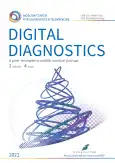包裹性坏死性胰腺炎
- 作者: Kitavina S.I.1, Petrovichev V.S.1, Ermakov A.N.2, Ermakov N.A.1, Nikitin I.G.1
-
隶属关系:
- Therapy and Rehabilitation Center
- Moscow State University of Medicine and Dentistry named after A.I. Evdokimov
- 期: 卷 2, 编号 4 (2021)
- 页面: 471-480
- 栏目: 临床病例及临床病例的系列
- URL: https://journals.rcsi.science/DD/article/view/71156
- DOI: https://doi.org/10.17816/DD71156
- ID: 71156
如何引用文章
详细
坏死性胰腺炎或胰腺坏死是急性胰腺炎中最严重的一种,死亡率很高。最适合诊断急性胰腺炎的时期是从疾病症状开始的3—5天。在此期间,胰腺水肿和暂时性缺血可能伪装为坏死,并在后续研究中消失,反之亦然,局部并发症可能在没有临床相关性的情况下发生。
目前,在急性胰腺炎的治疗中,放射诊断方法越来越受到重视,尤其是计算机断层扫描,因为它可以更精确地测量胰腺容积、评估病情和测量脾静脉直径,这在未来可能对胰腺坏死过程的预后形成有重要影响。
这篇文章介绍了一个罕见的急性胰腺炎并发症的临床病例包裹性坏死性胰腺炎,它是在消化系统疾病的背景下出现的。本文介绍了放射诊断方法在这些病理学动态检查中的符号学方面。该病例值得注意的是,患者入院时的疾病表现与典型水肿型急性胰腺炎相当。在急性胰腺炎病程的临床和形态学阶段之间以及在胰腺坏死形成之前进行的一系列动态CT图像显示负动态进一步增加,并伴有胰腺体分离和胰旁脓肿形成,这使得最清楚地显示疾病的逐步发展成为可能。治疗模式发生了改变,保守治疗被积极的手术策略所取代,随后是反复操作、动态计算机断层扫描和磁共振控制,直到患者病情好转。
迄今为止,放射诊断方法结合适当的治疗和手术方法可以改善坏死性胰腺炎的预后。
作者简介
Svetlana I. Kitavina
Therapy and Rehabilitation Center
Email: skitavina@yandex.ru
ORCID iD: 0000-0002-1280-1089
SPIN 代码: 9741-1675
MD, Cand. Sci. (Med.)
俄罗斯联邦, 3 Ivan’kovskoe shosse, 125367, MoscowVictor S. Petrovichev
Therapy and Rehabilitation Center
Email: petrovi4ev@gmail.com
ORCID iD: 0000-0002-8391-2771
SPIN 代码: 7730-7420
MD, Cand. Sci. (Med.)
俄罗斯联邦, 3 Ivan’kovskoe shosse, 125367, MoscowAleksandr N. Ermakov
Moscow State University of Medicine and Dentistry named after A.I. Evdokimov
Email: alx-ermakovv@yandex.ru
ORCID iD: 0000-0003-0675-8624
SPIN 代码: 9257-9319
MD
俄罗斯联邦, 3 Ivan’kovskoe shosse, 125367, MoscowNikolay A. Ermakov
Therapy and Rehabilitation Center
Email: n-ermakov@yandex.ru
ORCID iD: 0000-0002-1271-7960
SPIN 代码: 5985-9032
MD, Cand. Sci. (Med.)
俄罗斯联邦, 3 Ivan’kovskoe shosse, 125367, MoscowIgor G. Nikitin
Therapy and Rehabilitation Center
编辑信件的主要联系方式.
Email: igor.nikitin.64@mail.ru
ORCID iD: 0000-0003-1699-0881
SPIN 代码: 3595-1990
MD, Dr. Sci. (Med.), Professor
俄罗斯联邦, 3 Ivan’kovskoe shosse, 125367, Moscow参考
- Volkov V, Chesnokova N. Acute necrotizing pancreatitis: Actual questions of classification, diagnosis and treatment of local and widespread purulent-necrotic processes. Bulletin Chuvash University. 2014;(2):211–217. (In Russ).
- Bagnenko SF, Gol’tsov VR. Acute pancreatitis: current state of the problem and unresolved issues. Almanac A.V. Vishnevsky Ins Sur. 2008;3(3):104–112. (In Russ).
- Banks PA, Bollen TL, Dervenis C, et al. Classification of acute pancreatitis-2012: revision of the Atlanta classification and definitions by international consensus. Gut. 2013;62(1):102–111. doi: 10.1136/gutjnl-2012-302779
- Petrov MS, Shanbhag S, Chakraborty M, et al. Organ failure and infection of pancreatic necrosis as determinants of mortality in patients with acute pancreatitis. Gastroenterology. 2010;139(3):813–820. doi: 10.1053/j.gastro.2010.06.010
- Acute pancreatitis. Clinical recommendations of the Ministry of Health of the Russian Federation. Moscow, 2015. (In Russ). Available from: http://общество-хирургов.рф/upload/acute_pancreatitis_2016.doc. Accessed: 15.10.2021.
- Podoluzhny VI, Aminov IH, Rodionov IA. Acute pancreatitis. Kemerovo: POLIGRAF; 2017. 136 р. (In Russ).
- Bagnenko SF, Savello VE, Goltsov VR. Radiation diagnosis of pancreatic diseases: acute pancreatitis. In: Radiation diagnostics and therapy in gastroenterology: national guidelines. Ed. by G.G. Karmazanovsky Moscow: GEOTAR-Media; 2014. P. 349–365. (In Russ).
- Branco JC, Cardoso MF, Lourenço LC, et al. A rare cause of abdominal pain in a patient with acute necrotizing pancreatitis. GE Port J Gastroenterol. 2018;25(5):253–257. doi: 10.1159/000484939
- Zhang H, Chen G, Xiao L, et al. Ultrasonic/CT image fusion guidance facilitating percutaneous catheter drainage in treatment of acute pancreatitis complicated with infected walled-off necrosis. Pancreatology. 2018;18(6):635–641. doi: 10.1016/j.pan.2018.06.004
- Sahu B, Abbey P, Anand R, et al. Severity assessment of acute pancreatitis using CT severity index and modified CT severity index: Correlation with clinical outcomes and severity grading as per the Revised Atlanta Classification. Indian J Radiol Imaging. 2017;27(2):152. doi: 10.4103/ijri.IJRI_300_16
- Shahzad N, Khan MR, Inam Pal KM, et al. Role of early contrast enhanced CT scan in severity prediction of acute pancreatitis. J Pak Med Assoc. 2017;67(6):923–925.
- Avanesov M, Löser A, Smagarynska A, et al. Clinico-radiological comparison and short-term prognosis of single acute pancreatitis and recurrent acute pancreatitis including pancreatic volumetry. PLoS ONE. 2018;13(10):e0206062. doi: 10.1371/journal.pone.0206062
- Smeets XJ, Litjens G, da Costa DW, et al. The association between portal system vein diameters and outcomes in acute pancreatitis. Pancreatology. 2018;18(5):494–499. doi: 10.1016/j.pan.2018.05.007
- Van Grinsven J, van Vugt JLA, Gharbharan A, et al.; Dutch Pancreatitis Study Group. The association of computed tomography-assessed body composition with mortality in patients with necrotizing pancreatitis. J Gastrointest Surg. 2017;21(6):1000–1008. doi: 10.1007/s11605-016-3352-3
- Colvin SD, Smith EN, Morgan DE, et al. Acute pancreatitis: an update on the revised Atlanta classification. Abdom Radiol. 2020;45(5):1222–1231. doi: 10.1007/s00261-019-02214-w
- Baker ME, Nelson RC, Rosen MP, et al. Acr appropriateness Criteria acute pancreatitis. Ultrasound Quarterly. 2014;30(4):267–273. doi: 10.1097/RUQ.0000000000000099
- Shinagare AB, Ip IK, Raja AS, et al. Use of CT and MRI in emergency department patients with acute pancreatitis. Abdom Imaging. 2015;40(2):272–277. doi: 10.1007/s00261-014-0210-1
- Jin DX, McNabb-Baltar JY, Suleiman SL, et al. Early abdominal imaging remains over-utilized in acute pancreatitis. Dig Dis Sci. 2017;62(10):2894–2899. doi: 10.1007/s10620-017-4720-x
- Schreyer AG, Seidensticker M, Mayerle J, et al. Deutschsprachige terminologie der revidierten atlanta-klassifikation bei akuter pankreatitis: glossar basierend auf der aktuellen S3-Leitlinie zur akuten, chronischen und Autoimmunpankreatitis. Rofo. 2021;193(08):909–918. doi: 10.1055/a-1388-8316
- Sorrentino L, Chiara O, Mutignani M, et al. Combined totally mini-invasive approach in necrotizing pancreatitis: a case report and systematic literature review. World J Emerg Surg. 2017;12:16. doi: 10.1186/s13017-017-0126-5
- Namba Y, Matsugu Y, Furukawa M, et al. Step-up approach combined with negative pressure wound therapy for the treatment of severe necrotizing pancreatitis: a case report. Clin J Gastroenterol. 2020;13(6):1331–1337. doi: 10.1007/s12328-020-01190-9
- Skelton D, Barnes J, French J. A case of severe necrotising pancreatitis following ampullary biopsy. Ann R Coll Surg Engl. 2015;97(4):e61–e63. doi: 10.1308/003588415X14181254789646
补充文件















